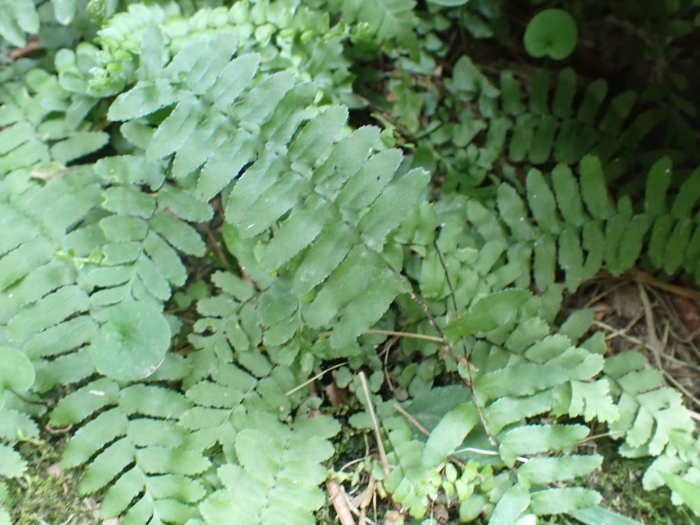Ebony Spleenwort
(Asplenium platyneuron)
Ebony Spleenwort (Asplenium platyneuron)
/
/

Cole Shoemaker
CC BY 4.0
Image By:
Cole Shoemaker
Recorded By:
Copyright:
CC BY 4.0
Copyright Notice:
Photo by: Cole Shoemaker | License Type: CC BY 4.0 | License URL: http://creativecommons.org/licenses/by/4.0/ | Rights Holder: Cole Shoemaker | Publisher: iNaturalist | Date Created: 2021-07-04T14:50:09-07:00 |




















































Estimated Native Range
Summary
Asplenium platyneuron, commonly known as ebony spleenwort or brownstem spleenwort, is a perennial herbaceous fern native to a variety of habitats including rocky slopes, forest floors, and mossy logs in eastern North America, from the Eastern half of the USA to Southeastern Canada. It is characterized by its dark, reddish-brown, glossy stipe and rachis (leaf stalk and midrib), which support a once-divided, pinnate leaf. The fertile fronds, which die off in the winter, are darker green and stand upright, while the sterile fronds are evergreen and lie flat on the ground, contributing to the plant’s year-round visual interest. Typically, this fern grows to a height of 6-20 inches (15-50 cm) with a similar spread.
Ebony spleenwort is valued for its ease of maintenance and adaptability to a range of soil types, making it suitable for rock gardens, woodland gardens, and as a ground cover in shaded areas. It is also a popular choice for terrariums due to its modest size and attractive foliage. While it can be difficult to establish initially, once settled, it requires minimal care. This fern prefers moist to dry conditions and can tolerate a range of light conditions, from partial sun to full shade. It is adaptable to both acidic and alkaline soils, as long as they are well-drained. Ebony spleenwort is not commonly affected by diseases or pests, making it a resilient choice for gardeners. However, it may struggle in overly wet or compacted soils.CC BY-SA 4.0
Ebony spleenwort is valued for its ease of maintenance and adaptability to a range of soil types, making it suitable for rock gardens, woodland gardens, and as a ground cover in shaded areas. It is also a popular choice for terrariums due to its modest size and attractive foliage. While it can be difficult to establish initially, once settled, it requires minimal care. This fern prefers moist to dry conditions and can tolerate a range of light conditions, from partial sun to full shade. It is adaptable to both acidic and alkaline soils, as long as they are well-drained. Ebony spleenwort is not commonly affected by diseases or pests, making it a resilient choice for gardeners. However, it may struggle in overly wet or compacted soils.CC BY-SA 4.0
Plant Description
- Plant Type: Fern
- Height: 0.5-1 feet
- Width: 0.5-1 feet
- Growth Rate: Moderate
- Flower Color: N/A
- Flowering Season: Non-Flowering
- Leaf Retention: Evergreen
Growth Requirements
- Sun: Part Shade, Full Shade
- Water: Low, Medium
- Drainage: Fast
Common Uses
Deer Resistant, Drought Tolerant, Low Maintenance, Rabbit Resistant, Rock Garden, Salt Tolerant
Natural Habitat
Rocky slopes, forest floors, and mossy logs in eastern North America
Other Names
Common Names: Brownstem Spleenwort , Doradille À Nervures Plates , Doradille Ébène
Scientific Names: Asplenium platyneuron , Asplenium ebeneum , Asplenium platyneuron var. incisum , Asplenium platyneuron var. platyneuron , Asplenium platyneuron var. serratum , Asplenium platyneuron f. hortonae , Asplenium platyneuron f. serratum , Asplenium ebeneum var. hortonae , Asplenium platyneuron f. dissectum , Asplenium platyneuron var. euroaustrinum
GBIF Accepted Name: Asplenium platyneuron (L.) Britton, Sterns & Poggenb.